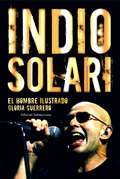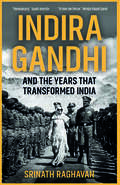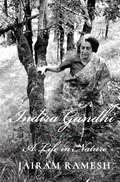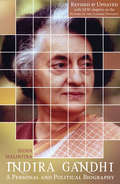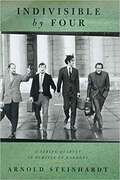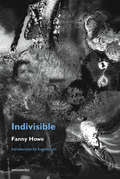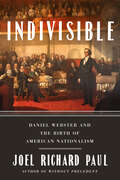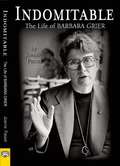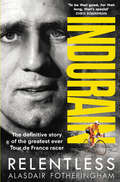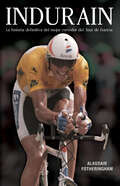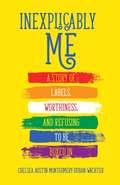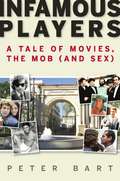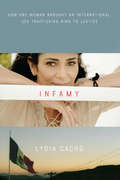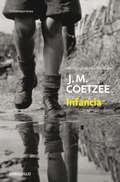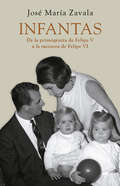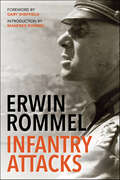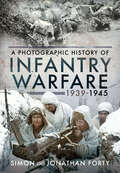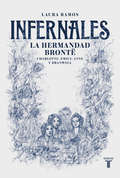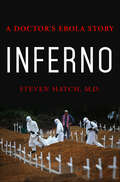- Table View
- List View
Indio Solari: El hombre ilustrado
by Gloria GuerreroPocos personajes surgidos de la música popular ofrecen tantos aspectosdestacables como el Indio Solari, ex líder de Patricio Rey y susredonditos de ricota. Él inventó formas de defensa y ataque a las fortalezas convencionales dela estupidez, abrió nuevos caminos, difundió una lírica propia queconvoca a montones de admiradores de distintas generaciones. Elindividuo conocido como el Indio Solari sigue siendo un misterio.Escrito con una precisión acorde con el ritmo y modo en que la voz delIndio se ajusta a sus canciones, es el mejor homenaje al iluminadoadalid del rock argentino, la recompensa más justa que pueden recibiruna actividad y una actitud determinantes en la sociedad y la cultura.Un libro serio, con el suspenso narrativo de una novela, que se lee y seoye como un reclamo ricotero insoslayable.
Indira Gandhi and the Years that Transformed India
by Srinath RaghavanThe gripping story of Indira Gandhi&’s premiership—and the profound influence she had on India Indira Gandhi&’s ascent as prime minister of India in 1966 was entirely unforeseen. But she soon emerged as one of the most powerful political leaders of her times, who transformed the world&’s largest democracy. She served as prime minister for a remarkable fifteen years, leaving behind a complex and deeply controversial legacy. In this fascinating account, Srinath Raghavan tells the story of Indira Gandhi&’s political career and the momentous changes that India experienced under her leadership. From her tentative start in high office to her remarkable electoral victories, the dark days of the Emergency of 1975–77, and her assassination at the hands of her bodyguards in 1984, Raghavan sheds new light on her politics and government, as well as on her adversaries and critics. He shows how the 1970s were the hinge on which the history of the country turned—and how Indira Gandhi transformed the new postcolonial nation into the India of today.
Indira Gandhi: A Life in Nature
by Jairam RameshIndira Gandhi, prime minister of India for sixteen years, was as charismatic as she was controversial–at once admired and criticized for her political judgements and actions. Yet beyond such debate, what has not been fully understood is her life-long communion with nature and how that defined her very being. Weaving personal, political and environmental history, politician-scholar Jairam Ramesh narrates the compelling story of Indira Gandhi, the naturalist. He tells us why and how she came to make a private passion a public calling; how her views on the environment remained steadfast even as her political and economic stances changed; how her friendships with conservationists led to far-reaching decisions to preserve India’s biodiversity; how she urged, cajoled and persuaded her colleagues as she took significant decisions particularly regarding forests and wildlife; and how her own finely-developed instincts and beliefs resulted in landmark policies, programmes, initiatives, laws and institutions, that have endured. Drawing extensively from unpublished letters, notes, messages and memos, Indira Gandhi: A Life in Nature offers a lively, conversational narrative of a relatively little known but fascinating aspect of Indira Gandhi’s tumultuous life. Equally, the book acts as a compass to India at a time when the country faces the formidable challenge of ensuring ecological security and sustainability in its pursuit of high economic growth.
Indira Gandhi: A Personal and Political Biography
by Inder MalhotraA definitive, incisive and no-holds-barred account of the life and times of one of India’s most charismatic and prominent leaders who has left a distinctive stamp on history For almost two decades, Indira Gandhi stood out the world’s most powerful woman. In India, there is hardly a neutral opinion about her. She is either adored or abused. Inder Malhotra’s biography explores objectively this highly complex and very private person – right from her childhood to her last days – who lived under constant public gaze and learnt to adjust her demanour to the occasion, rigorously concealing her true self and real feelings. This comprehensive work recounts her unusual and unhappy ‘love marriage’ to Feroze Gandhi and examines the ambivalent influence of her father, Jawaharlal Nehru, on her career. It also focuses on her relationship with her sons: Sanjay, her chosen heir, and his elder brother Rajiv, who, ironically, succeeded her as the prime minister of India. The author traces Indira Gandhi’s own evolution from a ‘dumb doll’ to the ‘empress of India’ and her downfall, the seeds of which were sown when she imposed the Emergency on 25 June 1975. This phase marked a dark period in the post-independence era. Her party (the Congress) lost the March 1997 general election and she was out of power for nearly three years. The author also describes the later revival in her fortunes, when she returned as prime minister in January 1980. During her second term, she had to order the Indian Army to enter the Golden Temple in Amritsar (the holiest shrine of the Sikhs) to flush out the militants hiding there. This move led to her being assassinated by her own Sikh bodyguards on 31 October 1984. In the revised and updated edition, Inder Malhotra throws light on the impact that Indira Gandhi had (and continues to have) on Indian politics after her death when her mantle fell on members of her family, including Rajiv Gandhi first and Sonia Gandhi later. This is not only a compulsive and gripping narrative about a remarkable personality but also a fascinating study of India after independence.E41
Indivisible By Four: A String Quartet In Pursuit Of Harmony
by Arnold SteinhardtThe Guarneri Quartet is fabled for its unique longevity and high-spirited virtuosity. Here is its story from the inside--a story filled with drama, humor, danger, compassion, and, of course, glorious music. A player who studies and performs the exalted string-quartet repertoire has opted for a very special life. Arnold Steinhardt, tracing his own development as a student, orchestra player, and budding young soloist, gives a touching account of how he and his intrepid colleagues were converted to chamber music despite the daunting odds against success. And he reveals, as no one has before, the intensely difficult process by which--on the battlefield of daily three-hour rehearsals--four individualists master and then overcome the confining demands of ensemble playing.
Indivisible, new edition (Semiotext(e) / Native Agents)
by Fanny HoweThe conclusion of a radically philosophical and personal series of Fanny Howe novels animated by questions of race, spirituality, childhood, transience, resistance, and poverty.First published by Semiotexte in 2001, Indivisible concludes a radically philosophical and personal series of Fanny Howe novels animated by questions of race, spirituality, childhood, transience, wonder, resistance, and poverty. Depicting the tempestuous multiracial world of artists and activists who lived in working-class Boston during the 1960s, Indivisible begins when its narrator, Henny, locks her husband in a closet so that she might better discuss things with God. On the verge of a religious conversion, Henny attempts to make peace with the dead by telling their stories.
Indivisible: Daniel Webster and the Birth of American Nationalism
by Joel Richard PaulThe story of how Daniel Webster popularized the ideals of American nationalism that helped forge our nation&’s identity and inspire Abraham Lincoln to preserve the Union When the United States was founded in 1776, its citizens didn&’t think of themselves as &“Americans.&” They were New Yorkers or Virginians or Pennsylvanians. It was decades later that the seeds of American nationalism—identifying with one&’s own nation and supporting its broader interests—began to take root. But what kind of nationalism should Americans embrace? The state-focused and racist nationalism of Thomas Jefferson and Andrew Jackson? Or the belief that the U.S. Constitution made all Americans one nation, indivisible, which Daniel Webster and others espoused? In Indivisible, historian and law professor Joel Richard Paul tells the fascinating story of how Webster, a young New Hampshire attorney turned politician, rose to national prominence through his powerful oratory and unwavering belief in the United States and captured the national imagination. In his speeches, on the floors of the House and Senate, in court, and as Secretary of State, Webster argued that the Constitution was not a compact made by states but an expression of the will of all Americans. As the greatest orator of his age, Webster saw his speeches and writings published widely, and his stirring rhetoric convinced Americans to see themselves differently, as a nation bound together by a government of laws, not parochial interests. As these ideas took root, they influenced future leaders, among them Abraham Lincoln, who drew on them to hold the nation together during the Civil War. As he did in Without Precedent and Unlikely Allies, Joel Richard Paul has written in Indivisible both a compelling history and a fascinating account of one of the founders of our national perspective.
Indomitable: The Life of Barbara Grier
by Joanne Passet"Whatever else will be said about her--and you can bet there will be plenty, because Barbara was no stranger to controversy--the one thing that is true above all else is that she was the most important person in lesbian publishing in the world. Without her boldness and her audacity, there might not be the robust lesbian publishing industry there is today. ” --Teresa DeCrescenzo Barbara Grier--feminist, activist, publisher, and archivist--was many things to different people. Perhaps most well known as one of the founders of Naiad Press, Barbara’s unapologetic drive to make sure that lesbians everywhere had access to books with stories that reflected their lives in positive ways was legendary. Barbara changed the lives of thousands of women in her lifetime. For the first time, historian Joanne Passet uncovers the controversial and often polarizing life of this firebrand editor and publisher with new and never before published letters, interviews, and other personal material from Grier’s own papers. Passet takes readers behind the scenes of The Ladder, offering a rare window onto the isolated and bereft lives lesbians experienced before the feminist movement and during the earliest days of gay political organizing. Through extensive letters between Grier and her friend novelist Jane Rule, Passet offers a virtual diary of this dramatic and repressive era. Passet also looks at Grier’s infamous "theft” of The Ladder’s mailing list, which in turn allowed her to launch and promote Naiad Press, the groundbreaking women’s publishing company she founded with partner Donna McBride in 1973. Naiad went on to become one of the leaders in gay and lesbian book publishing and for years helped sustain lesbian and feminist bookstores--and readers--across the country. JOANNE PASSET is Professor of History Emerita at Indiana University East. Her previous books include Sex Variant Woman: The Life of Jeannette Howard Foster, Sex Radicals and the Quest for Women's Equality, Cultural Crusaders: Women Librarians in the American West, and Aspirations and Mentoring in an Academic Environment (with Mary Niles Maack).
Indurain
by Alasdair FotheringhamMiguel Indurain is Spain’s greatest cyclist of all time and one of the best Tour racers in history. He is the only bike rider to have won five successive Tours de France, as well as holding the title for the youngest ever race leader in the Tour of Spain. This is his story. As the all-conquering hero of the 90s, Indurain steadfastly refused to be overwhelmed by fame; remaining humble, shy and true to his country roots. Along with his superhuman calmness, iron will-power and superb bike handling skills, he was often described as a machine. Yet 1996 saw Indurain, the Tour’s greatest ever champion, spectacularly plummet, bringing his career and supremacy to an abrupt end.In Indurain, Alasdair Fotheringham gets to the heart of this enigmatic character, reliving his historic accomplishments in vibrant colour, and exploring how this shaped the direction taken by generations of Spanish racers - raising Spanish sport to a whole new level.
Indurain: La historia definitiva del mejor corredor del Tour de Francia
by Alsdair FotheringhamLa historia definitiva del mejor corredor del Tour de Francia: Miguel Indurain. Como el gran conquistador y heroe de los 90s, Miguel Indurain rápidamente huyó de la fama y de las abrumaciones; manteniéndose humilde, tímido y muy cercano a sus raices y a su tierra. A través de su personalidad, su voluntad de hierro y sus soberbias habilidades para dominar la bicicleta, Indurain fue descrito muchas veces como una máquina perfecta del ciclismo. Todavía en 1996 se vió al mejor campeón del Tour de todos los tiempos, con una voluntad de hierro y una fuerza arrolladora, año en el que de manera abrupta decidió poner fin a su carrera profesional y a su supremacía. En este libro, Alasdair Fotheringham llega al corazón de este enigmático campeón, reviviendo sus logros históricos y explorando la dirección que siguieron varias generaciones de ciclistas españoles, llevando a su deporte a un nivel jamás antes conocido en España. A través de decenas de entrevistas con directores del Tour de Francia, ciclistas contemporáneos, compañeros de equipo y a Prudencio Indurain, el autor nos desvela en esta vibrante biografía, el lado más humano de uno de los mejores deportistas de la historia de España. La crítica ha dicho...«Un relato que retrata el lado más humano del pentampeón de la ronda francesa a través de entrevistas con su entorno familiar, entre ellos su hermano 'Pruden', directores y ciclistas más cercanos.»Europa Press«Alasdair Fotheringham, afincado en España, indaga en el lado más humano del único ciclista que ha sido capaz de vencer cinco consecutivas en el Tour de Francia.»El País «La apasionante historia de un campeón excepcional y cercano. Indurain, gran biografía, muy bien escrita y documentada.»Pedro Pablo Alonso«Consigue brillantemente hacernos llegar una imagen muy ajustada a la personalidad de Indurain.»Ciclismoylectura «El que ha vivido esa época dorada del ciclismo español, disfrutará de estas páginas.»Alberto López Escuer, Salesianos cooperadores
Industrial Espionage Is More Effective Than R&D
by Erik Meyersson Curt NickischHBR Interview. An Interview with Erik Meyersson by Curt Nickisch Two researchers surveil the economic returns that spying produced during the Cold War.
Inexplicably Me: A Story of Labels, Worthiness, and Refusing to Be Boxed In
by Chelsea Austin Montgomery-Duban WächterA hilariously moving and inspirational memoir of a girl with two gay dads, navigating her way through life with joy, love, gratitude, and an excellent sense of humor. As the daughter of two gay fathers in the 90s, Chelsea has always had a different outlook than some people. And yet, her message is one of universal importance – love is the most important force in the world. Through her moving and at times hilarious memoir, Chelsea reflects on how we are all much more similar than we are different. Living &“two doors down from normal,&” Chelsea quickly learned that society loves to put people in boxes, but these boxes do not always reflect how we feel about ourselves. Through Inexplicably Me, Chelsea works to bring people together in love and acceptance and to illustrate that, while her story may seem worlds away from others, we all strive for happiness and love. From sharing the stage with President Obama when she was only eighteen years old, to her father spending her senior year of college in federal prison camp, to her biological mother dying of cancer when she was only 56, Chelsea explores her painful and joyful experiences with the hope that readers will find inspiration to face their own challenges and embrace their own joys. Inexplicably Me is a bridge for those who fear what they don&’t understand, as well as a possibility for those who have lacked love in their lives to see how they can start to access their self-worth, begin achieving their dreams, and start loving themselves again. Most of all, it is a reminder that everyone will have an opinion about who you are supposed to be, but you, and only you, get to decide exactly who it is you want to be.
Infamous Players
by Peter BartIn 1967, Peter Bart, then a young reporter for theNew York Times, decided to upend his life and enter the dizzying world of motion pictures. Infamous Playersis the story of Bart’s remarkable journey at Paramount, his role in its triumphs and failures, and how a new kind of filmmaking emerged during that time. When Bart was lured to Paramount by his friend and fellow newcomer, the legendary Robert Evans, the studio languished, its slate riddled with movies that were out of touch with the dynamic ’60s. By the time Bart left Paramount, in 1975, the studio had completed an extraordinary run with such films asThe Godfather,Rosemary’s Baby,Harold and Maude,Love Story,Chinatown,Paper Moon, andTrue Grit. But this new golden era at Paramount was also fraught with chaos and company turmoil. Drugs, sex, runaway budgets, management infighting, and even the Mafia started finding their way onto the Paramount back lot, making it surely one of the worst-run studios in the history of the movie industry. As Peter reflects on the New Hollywood era at Paramount with insider details and insightful analysis, here too are his fascinating recollections of the icons from that era: Warren Beatty, Steve McQueen, Robert Redford, Clint Eastwood, Jack Nicholson, Marlon Brando, Al Pacino, Francis Ford Coppola, Roman Polanski, and Frank Sinatra, among others. For over five decades, Peter Bart has viewed Hollywood from an incomparable vantage point. The stories he tells and the lessons we learn fromInfamous Players are essential for anyone who loves movies.
Infamous Players
by Peter BartIn 1967, Peter Bart, then a young family man and rising reporter for the New York Times, decided to upend his life and enter into the dizzying world of motion pictures. Infamous Players is the story of Bart's whirlwind journey at Paramount, his role in its triumph and failures, and how a new kind of filmmaking emerged during that time.When Bart was lured to Paramount by his friend and fellow newcomer, the legendary Robert Evans, the studio languished, its slate riddled with movies that were out of touch with the dynamic sixties. By the time Bart had left Paramount in 1975, the studio had completed a remarkable run with such films as The Godfather, Rosemary's Baby, Harold and Maude, Love Story, Chinatown, Paper Moon, and True Grit. But this new golden era at Paramount was also fraught with chaos and company turmoil. Drugs, sex, runaway budgets, management infighting, and even the Mafia started finding their way onto the Paramount backlot, making it surely one of the worst-run studios in the history of the movie industry.As Peter reflects on the New Hollywood era at Paramount with behind-the-scenes details and insightful analysis, here too are his fascinating recollections of the icons from that era: Warren Beatty, Steve McQueen, Robert Redford, Clint Eastwood, Jack Nicholson, Marlon Brando, Al Pacino, Francis Ford Coppola, Roman Polanski, and Frank Sinatra among others.For over five decades, first on the inside as a studio executive, and later as the longtime editor-in-chief of Variety, Peter Bart has viewed Hollywood from an incomparable vantage point. The stories he tells and the lessons we learn from Infamous Players are essential for anyone who loves movies.
Infamy: How One Woman Brought an International Sex Trafficking Ring to Justice
by Lydia CachoIn 2005, after publishing her book The Demons of Eden-where she denounced the very powerful men behind the a Mexican child pornography ring-Lydia Cacho became a target. Exactly eight months after the publication of the book, one morning as she was making her way to work, Lydia was apprehended by the police from the neighboring state of Puebla, and taken into custody during a nightmarish 24 hours during which she was tortured, intimidated and abused.In this chilling memoir, comparable to Ayaan Hirsi Ali's Infidel, Lydia tells her story and exposes the horrific ways in which women-and young girls in particular-are abused then disposed of, while an oftentimes corrupt government simply sits and watches.
Infancia
by J. M. CoetzeeInfancia es la primera parte de las memorias noveladas de J.M. Coetzee, que se completan con Juventud y Verano. Tiene diez años. Vive en Worcester, una pequeña localidad al norte de Ciudad del Cabo, con una madre a la que adora y detesta a la vez, un hermano menor y un padre por quien no siente respeto alguno. Lleva una doble vida: en el colegio es el alumno modélico, el primero de la clase; en casa, un pequeño déspota. Los secretos, los engaños y los miedos le atormentan; el amor por la granja familiar y por el veld, las desnudas mesetas sudafricanas, le arraigan a la tierra. J.M. Coetzee vuelca su talento de narrador sobrio, mesurado y elegante en este relato lleno de fuerza, en el que evoca su infancia a comienzos de los años cincuenta; escenas de una vida de provincias donde la inocencia en su estado más puro y la violencia soterrada forman parte tanto de la propia historia como de la de Sudáfrica. Reseñas:«Estas son las memorias de infancia de un alma sensible, que absorbe los impulsos elementales de la vida para utilizarlos posteriormente.»The Washington Post Book World «J.M. Coetzee escribe, como siempre, con una elegancia extraordinaria.»The Atlantic Montly
Infancia es destino
by Guadalupe LoaezaCon interesantes anécdotas, datos curiosos y recuerdos conmovedores, en estos textos, publicados originalmente como parte de su columna en el periódico Reforma, Guadalupe Loaeza recrea los años en los que se formaron el carácter, la personalidad, las fobias, las pasiones, las virtudes y defectos de grandes personajes. Una fascinante reconstrucción de la niñez de 50 personajes que han marcado la historia, la política, el arte y la literatura. Con el estilo accesible y ameno que la han convertido en una de las comunicadoras más seguidas de México, la autora hace el recuento de los eventos determinantes en la infancia de figuras que han dejado huella en la política, la música, las artes visuales, los deportes, la literatura, la ciencia y los negocios. Con interesantes anécdotas, datos curiosos y recuerdos conmovedores, en estos textos, publicados originalmente como parte de su columna en el periódico Reforma, Guadalupe Loaeza recrea los años en los que se formaron el carácter, la personalidad, las fobias, las pasiones, las virtudes y defectos de grandes personajes. Conoceremos la niñez de Frida Kahlo, Marlon Brando, Michael Jackson, Al Capone, Gabriel García Márquez, Juan Rulfo, Liza Minelli, Agustín Lara, Porfirio Díaz, Adolf Hitler, Charles Chaplin, Mario Vargas Llosa, Marcial Maciel y Mario Benedetti, entre otros. Reseña: "Infancia es destino de Guadalupe Loaeza es un libro hermoso y que permite al lector comprender mejor las circunstancias de muchos personajes, penetra en la intimidad de todos ellos pero que, a pesar de lo que pudiera parecer una intromisión, sus vidas son abordadas con gran respeto. Una lectura muy recomendable". SDPnoticias.com
Infantas: De la primogénita de Felipe V a la sucesora de Felipe VI
by José María ZavalaUn recorrido apasionante por el pasado, presente y futuro de las mujeres de la dinastía borbónica, veinte infantas que pudieron reinar en España De la hija de Felipe V a la del actual Príncipe de Asturias, Leonor. ¿La última? ¿Sabía por qué a la segunda infanta de la dinastía, María Josefa Carmela de Borbón y Sajonia, se la motejó como «la de los huesos frágiles»? ¿Y el verdadero motivo de que a la infanta Carlota Joaquina se la apodase «la intrigante» o a Luisa Carlota «la celestina»? ¿Conoce la razón por la cual la infanta Elvira desfila por estas páginas como «la fogosa» y a la infanta Cristina se la denomina «la equilibrista»? Romances secretos, infidelidades, complots, muertes trágicas, matrimonios regios por razones de Estado... y divorcios sonados. Esta completa galería de infantas se compone de veinte inusitados retratos que abarcan los últimos siglos de la historia de España hasta la actualidad, donde la infanta Leonor se erige como inmediata sucesora de su padre, el príncipe Felipe, quién sabe si Felipe VI, rey de España, algún día. Reseñas:«Zavala nos da un inolvidable paseo de la mano por la historia.»Julia Navarro
Infantry Attacks
by Erwin RommelLegendary German general Erwin Rommel analyzes the tactics that led to his success. Field Marshal Erwin Rommel exerted an almost hypnotic influence not only over his own troops but also over the Allied soldiers of the Eighth Army in the Second World War. Even when the legend surrounding his invincibility was overturned at El Alamein, the aura surrounding Rommel himself remained unsullied. In this classic study of the art of war Rommel analyses the tactics that lay behind his success. First published in 1937 it quickly became a highly regarded military textbook, and also brought its author to the attention of Adolph Hitler. Rommel was to subsequently advance through the ranks to the high command in the Second World War. As a leader of a small unit in the First World War, he proved himself an aggressive and versatile commander with a reputation for using the battleground terrain to his own advantage, for gathering intelligence, and for seeking out and exploiting enemy weaknesses. Rommel graphically describes his own achievements, and those of his units, in the swift-moving battles on the Western Front, in the ensuing trench warfare, in the 1917 campaign in Romania, and in the pursuit across the Tagliamento and Piave rivers. This classic account seeks out the basis of his astonishing leadership skills, providing an indispensable guide to the art of war.
Infantry Warfare, 1939–1945: A Photographic History
by Simon Forty Jonathan FortyThe infantry can always be found at the sharp end of the battlefield. You may be able to crush an opponent with armour or artillery, but there’s only one way to take and hold ground and that’s with riflemen – the ‘poor bloody infantry’. And it is the infantrymen of the Second World War – from all sides, Allied and Axis – who are the subject of this highly illustrated history. It uses over 400 wartime photographs plus contemporary documents and other illustrations to show the developments in equipment, training and tactical techniques and to give an insight into the experience of the infantry soldier during the conflict. Although the infantry were critical to the war effort, their contribution is often overshadowed by the more dramatic roles played by soldiers with more specialized skills – like tank crew, paratroopers and special forces. They also suffered devastating casualties, in particular during the last phase of the war in the west when around 20 per cent of an infantry division’s riflemen were likely to die and over 60 per cent could expect to be wounded. So as well as describing how the infantry fought, the authors look at the motivation which kept them fighting in awful conditions and despite brutal setbacks. The result is a thorough, detailed and revealing portrait of infantry warfare over seventy years ago.
Infermieraaa!!
by Sarah Jane Butfield Michela TettoSara Jane ha solo sedici anni quando decide di diventare un'infermiera; fino ad allora non ha mai avuto alcuna ambizione lavorativa, voleva soltanto finire la scuola, lavorare come cassiera ai supermercati Woolsworth e sposarsi. Poi tutto cambia, e lei si ritrova a indossare un’uniforme rosa fluo, e a studiare per entrare in una scuola d’infermieristica. Cos’ha provocato questo sorprendente cambio di direzione? Cosa succede quando va via di casa e va a vivere in città con una coinquilina che ama solo divertirsi? Ma la vera domanda è: lei è tagliata per il lavoro di infermiera? In questa biografia, l'autrice ha ripercorso il cammino da lei affrontato per diventare un'infermiera, dagli esordi del suo corso di formazione nella scuola per infermieri di Colchester fino al suo primo giorno di lavoro come infermiera qualificata, descrivendoci episodi ed aneddoti, momenti felici e tristi, difficoltà e soddisfazioni, che hanno segnato la sua carriera da infermiera, con uno stile semplice che sa farci emozionare e divertire allo stesso tempo, coinvolgendoci nelle mille sfumature che hanno costellato la sua vita.
Infernales. La hermandad Brontë: Charlotte, Emily, Anne y Branwell
by Laura RamosInfernales es la biografía más completa sobre la familia Brontë, y al mismo tiempo la apasionante historia de una hermandad marcada con sangre y literatura. En un inhóspito y alejado pueblo de Inglaterra, a mediados del siglo diecinueve, tiene lugar un suceso extraordinario: tres muchachas pobres y poco saludables se convierten en novelistas de fama mundial. Escribiendo desde la infancia, las Brontë -Charlotte, Emily, Anne-, junto con Branwell, único varón en la cofradía de hermanos, componen poemas, cuentos y obras de teatro por los que desfilan reinos y batallas, crímenes y ardides, parentescos dudosos y amores prohibidos. Con el tiempo, Charlotte llegará a ser una celebrada autora; Emily mantendrá el anonimato mientras su Cumbres Borrascosas escandaliza Gran Bretaña; Anne publicará La inquilina de Wildfell Hall, una de las primeras novelas feministas; Branwell, poeta maldito, llevará el ideal romántico hasta los límites de la autodestrucción y será increíblemente proscripto de la historia.
Inferno: A Doctor's Ebola Story
by Steven Hatch"Hatch packs a wealth of knowledge into the book...poignant." -Associated PressDr. Steven Hatch, an infectious disease specialist, first came to Liberia in November 2013 to work at a hospital in Monrovia. Six months later, several of the physicians he had served with were dead or unable to work, and Ebola had become a world health emergency. Inferno is his account of the epidemic that nearly consumed a nation, as well as its deeper origins.Hatch returned with the aid organization International Medical Corps to help establish an Ebola Treatment Unit. Alongside a devoted staff of expats and Liberians in a hastily constructed facility nestled into the jungle, Hatch witnessed the unit's physicians, nurses, other caregivers, and patients selflessly helping others, preserving hope in the face of fear, and maintaining dignity across the divide of health and illness. And, over repeated visits during the course of the outbreak, Hatch came to understand the Ebola catastrophe not only as a contagious virus but as a product of Liberia's violent history and America's role in it.Powerful and clear-eyed, Inferno not only explores a deadly virus and an afflicted country, but also reveals how the Ebola outbreak stoked nativist anxieties that were exploited for political gain in the United States and around the world. In telling one doctor's story, Inferno demonstrates how generations of inequality left Liberia vulnerable to crisis, and how similar circumstances might fuel another plague elsewhere. By understanding and alleviating those circumstances, Hatch writes, we may help smother the fire next time.
